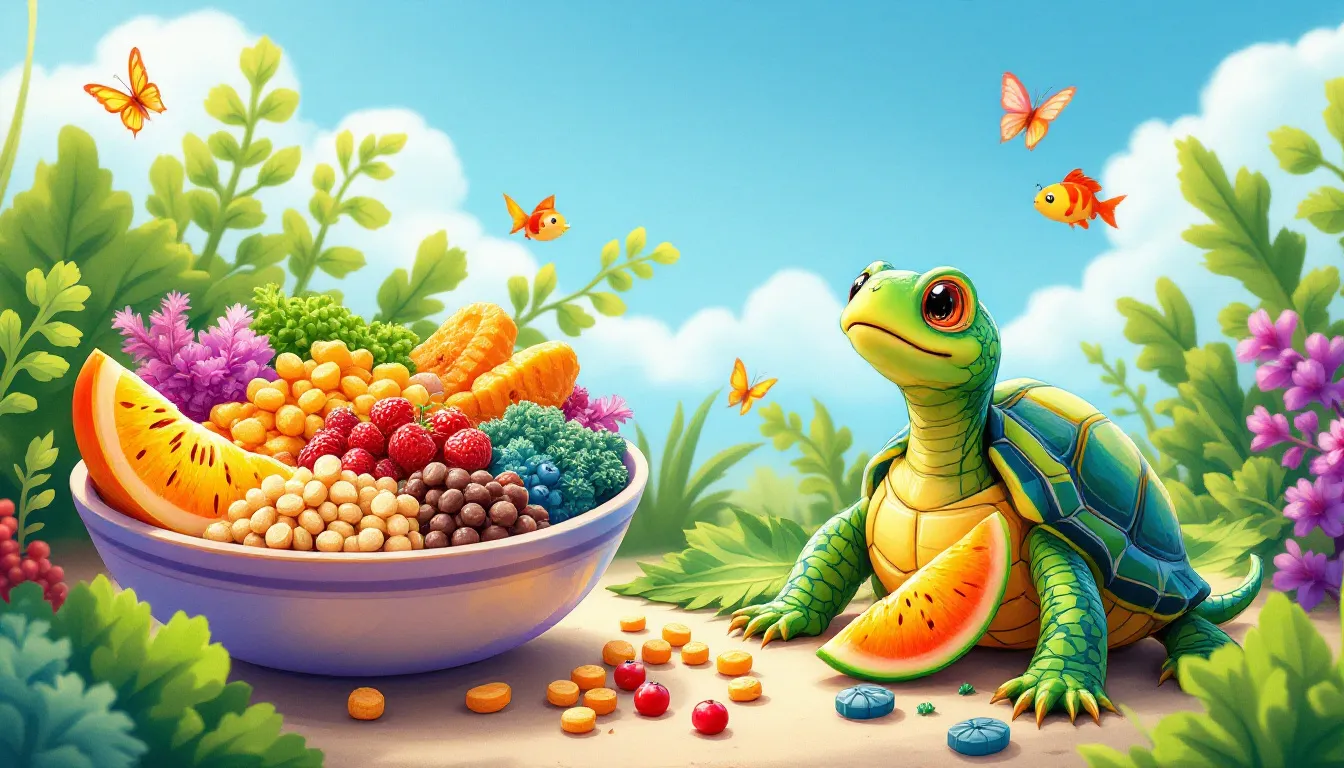If you’re looking for “what can I feed red eared slider turtles as a snack,” you’re in the right place. This article covers a variety of safe, tasty, and nutritious snacks ranging from vegetables and fruits to proteins and commercial treats. Learn how to keep your turtle’s diet balanced and interesting.
Key Takeaways
- A balanced diet for red-eared slider turtles includes safe vegetables, fruits in moderation, and protein sources to support health.
- Non-toxic aquatic plants can enhance the turtle’s habitat and provide nutrition while promoting foraging behavior.
- Proper snack preparation and feeding frequency are essential to prevent health issues and ensure a nutritious diet.
Safe Vegetables as Snacks

Vegetables are a staple in the diet of a red-eared slider turtle and should not be overlooked. They provide essential nutrients and add variety to your turtle’s diet, making mealtime more interesting. Romaine lettuce, collard greens, and mustard greens are excellent vegetables to include in a red-eared slider’s diet. These dark leafy greens are packed with vitamins and minerals that support overall health.
A variety of vegetables keeps your turtle interested in its food. Mix in options like green beans and dandelion greens to keep things exciting. Avoid iceberg lettuce, as it has little nutritional value. Including a diverse range of veggies ensures that your turtle gets a balanced diet and all the nutrients it needs.
Remember, a healthy turtle is a happy turtle. Providing a mix of nutritious vegetables ensures your pet’s good health and makes mealtime a delightful experience.
Fruits to Feed Sparingly
Fruits can be a delightful treat for your red-eared slider turtle, but they should be fed sparingly. Fruits should only make up about 10-15% of your turtle’s diet due to their high sugar content. Overfeeding fruits can disrupt your turtle’s diet and lead to parasite problems.
Some fruits that are safe for your turtle include strawberries, melons, apples (without seeds), pears, peaches, and blueberries. These fruits offer a sweet burst of flavor that your turtle will enjoy. Feed these fruits occasionally and avoid making them a regular part of the diet.
A proper diet is crucial for your red-eared slider. Offering fruits as occasional treats allows your turtle to enjoy its food without compromising its health. This balance prevents feeding issues and keeps your red eared slider’s diet varied and interesting.
Protein-Rich Snack Options
Animal protein is crucial for the diet of young red-eared slider turtles. This protein supports their rapid growth and development. Superworms, fish, and amphibians are excellent sources of animal protein. Providing a variety of protein sources ensures your turtle receives balanced nutrition.
Incorporating protein-rich foods like small fish or cooked chicken can add variety to the diet alongside mealworms. Such variety keeps your turtle interested in meals and ensures it gets necessary nutrients for optimal health.
Balance protein with vegetables. A varied diet of plant and animal-based foods prevents health problems and supports overall well-being. Offering a mix of protein sources caters to your turtle’s natural eating habits and promotes a balanced diet.
Though essential, too much protein can lead to health problems. Always ensure that your turtle’s diet is balanced and consult with a vet if you’re unsure about the best feeding practices for your pet.
Non-Toxic Aquatic Plants

Non-toxic aquatic plants are a fantastic addition to the environment of a red-eared slider. They provide nutrition and create a natural habitat that encourages foraging behavior. Frogbit and hornwort are safe and appealing options. These plants serve as a nutritious snack and help keep the tank clean.
Water lettuce offers both shelter and a nutritious snack for red-eared sliders. Java moss and common eel grass are also great choices that enhance the diet and habitat. These plants in the tank promote a healthy environment and support your turtle’s overall well-being.
By incorporating non-toxic aquatic plants into your turtle’s habitat, you provide a natural and enriching environment. This supports both their dietary needs and their mental and physical health, leading to a happy and healthy turtle.
Commercial Turtle Treats

Commercial turtle treats offer a convenient and nutritious option for red-eared sliders. Brands like Flukers®, Mazuri®, and ZooMed® offer high-quality foods that cater to the specific needs of these turtles. Designed to provide balanced nutrition, these treats are easy to find in pet stores. Red eared sliders eat these treats as part of their diet.
Jurassi Turtle food is known for its high-quality ingredients but should be fed sparingly due to its richness. Omega One Turtle Pellets are another popular choice, offering balanced nutrition that supports a healthy turtle. ZooMed Natural Aquatic Turtle Formula has different formulas for hatchlings, juveniles, and adults, making it a versatile option for turtles at different life stages.
Select high-quality commercial treats to ensure your turtle’s health. Brands like Mazuri are favored for their ease of consumption, especially for young turtles. Avoid lower-quality options like Reptomin, which may lack necessary vitamins and have too high protein content.
Incorporating commercial turtle treats into your red-eared slider’s diet provides a convenient and nutritious option that supports overall health.
Preparing Snacks Safely
Preparing snacks for your red-eared slider turtle involves a few simple steps. Always wash vegetables thoroughly to remove any pesticides or contaminants. This ensures that your turtle is eating safe and clean food.
Chop vegetables into bite-sized pieces to make them easier for your turtle to consume. This is especially important for young turtles who may struggle with larger pieces. When it comes to fruits, always remove seeds and pits to prevent choking hazards.
Following these steps ensures the snacks you offer are nutritious and safe for your turtle to eat. Safe preparation practices maintain your turtle’s health and prevent potential feeding issues.
How Often to Give Snacks
Knowing how often to give snacks is crucial for maintaining a balanced diet for your red-eared slider. Feed juvenile turtles daily due to their higher energy needs. Adult turtles can be fed every two to three days, though some owners prefer smaller daily portions.
Avoid overfeeding, as it can lead to obesity and other health issues. Snacks like cooked chicken should be given rarely to prevent health problems. Balancing snacks with regular meals ensures your turtle gets all necessary nutrients without overindulging.
Understanding the proper feeding frequency helps maintain your turtle’s health and prevent diet-related issues. This balance keeps your turtle happy and healthy.
Summary
In summary, providing a variety of safe and nutritious snacks is essential for the health and happiness of your red-eared slider turtle. From vegetables and fruits to protein-rich options and commercial treats, each snack type offers unique benefits that contribute to a balanced diet.
Remember, the key to a healthy turtle is balance and variety. By following these guidelines, you can ensure that your turtle enjoys a diverse and nutritious diet, promoting their overall well-being. Happy feeding!
Frequently Asked Questions
Can I feed my red-eared slider turtle iceberg lettuce?
Feeding your red-eared slider turtle iceberg lettuce is not advisable due to its low nutritional value. Instead, choose romaine lettuce or other dark leafy greens for a healthier diet.
How often should I give my turtle fruits as a snack?
You should offer fruits to your turtle as occasional treats, making up only 10-15% of their total diet. This ensures a balanced nutrition while still allowing for a tasty snack.
What are some safe protein-rich snacks for my turtle?
For a safe protein-rich snack for your turtle, consider offering mealworms, small fish, or cooked chicken. A varied diet is essential for maintaining their balanced nutrition.
Can I include aquatic plants in my turtle’s tank?
Yes, you can include non-toxic aquatic plants such as frogbit, hornwort, and water lettuce in your turtle’s tank, as they offer both nutrition and a natural habitat for your turtle.
How do I prepare vegetables and fruits for my turtle?
To ensure your turtle’s safety, thoroughly wash vegetables, chop them into bite-sized pieces, and remove any seeds or pits from fruits. This preparation helps prevent choking hazards and promotes better feeding.

